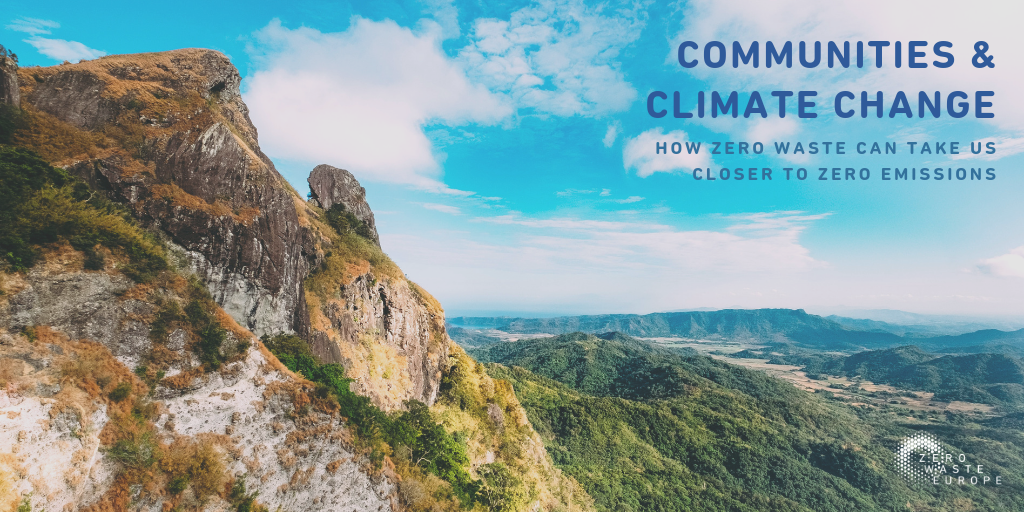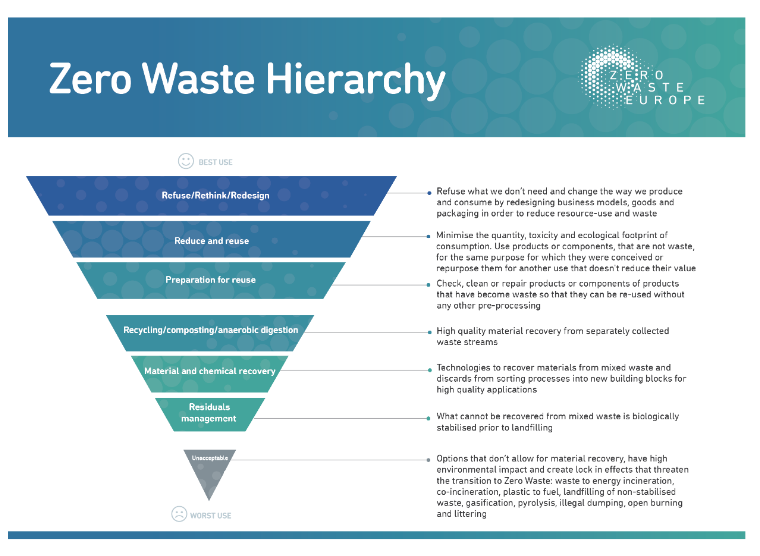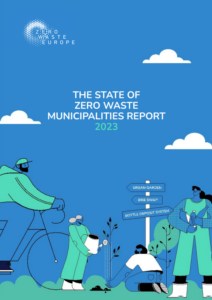Communities and Climate Change: how a zero waste approach can take us closer to zero emissions

In this blog, our Cities Programme Coordinator Jack McQuibban showcases how commitments towards adopting a zero waste approach can play a central role in reducing greenhouse gases at the local level through the effective management of natural resources and the re-designing of products and the communities we live in to prevent waste being generated in the first place.
In 2015, world leaders signed up to the Paris Agreement. A bold set of ambitious promises set to limit global warming to 1.5°C above pre-industrial levels and therefore protect our communities, wildlife, oceans and natural ecosystems from the devastating effects of climate change.
Nearly five years on, progress has been painfully slow and ineffective. Earlier this year, PACE released their second Circularity Gap Report which highlights that only 9% of the world is circular and that the trends all currently point to that figure getting worse, with resource extraction and emissions of greenhouse gases (GhG) increasing in the past two years.
Zero waste as the practical translation of a Circular economy.
Zero Waste communities are living examples of the Circular Economy, its viability and its environmental, economic, and occupational benefits.
Karmenu Vella, former EU Commissioner for the Environment, Maritime Affairs and Fisheries
The 2019 Circularity Gap report identifies that whilst globally the world is only 9% circular, in Europe our economies are only slightly better at 12% circular, showcasing the big challenges we face ahead of us. But this also represents a huge opportunity, with 88% of our economy left to be transformed into a resource efficient system.
The Zero Waste International Alliance defines zero waste as “the conservation of all resources by means of responsible production, consumption, reuse, and recovery of products, packaging, and materials without burning and with no discharges to land, water, or air that threaten the environment or human health.”
The concept of zero waste embodies and captures what the circular economy is all about. Zero waste not only provides a tangible and effective framework for implementing circular economic policies at the local level, but it also creates opportunities to bring numerous social, economic and environmental benefits for communities. Whilst zero waste of course helps to reduce our environmental impact, it also provides an opportunity for municipalities to reduce their expenses, with ultimately less waste to manage, allowing for extra savings to either be reinvested into other public services or decrease taxes for citizens. A local zero waste approach also helps build jobs and increase social cohesion within the community, as a circular economy is centred around local businesses, schools and residents.
Where zero waste helps reduce emissions
As the Circularity Gap report helps to highlight, there are a number of different critical moments where a zero waste approach could comprehensively reduce the amount of GhG emissions being emitted and therefore, reduce the volume of emissions that are the largest drivers of climate change worldwide. As highlighted in the report, these critical moments include:
- Take – The stage when natural resources are extracted from the planet, for example when drilling for oil or gas, the production and manufacturing of crops in agriculture, or sourcing timber for construction or the mining of minerals.
- Process – Once extracted and sourced, these raw materials typically then undergo industrial processing so that they can be successfully adapted into modern commodities, such as producing metals from ores, plastic from oil, and cement from limestone.
- Produce – Once these materials have been refined and processed, they can then be used explicitly for the production, manufacturing and assembly of everyday products that we use in modern society, ranging from large scale construction of roads and houses to the production of fashion garments and food packaging.
- Provide – These finished products can, in turn, be used to provide services and access to products that satisfy the needs of modern society, such as communication services, retail, transport and many more needs which are embedded within the world we live in today.
- End-of-use – A zero waste approach ensures that products and materials continue to retain their value and have a functional use within an economy that is circular. If products and materials cannot be reused, repaired or recycled then they will have a negative impact on our efforts to address and mitigate against climate change, by dispersing into the environment as unrecoverable waste or adding to GhG emissions. According to the report, only 8.4 billion tonnes or 9.1% of our total material use in the EU is cycled, with the remainder incinerated, landfilled, or dispersed into the environment.
For cities and municipalities wishing to reduce their impact on the environment and climate by transitioning to a more circular economy, the Zero Waste Hierarchy contains several key principles that can from the basis of a climate change mitigation plan at the local level:

Re-design business models
By changing the way we consume and produce goods we can immediately reduce the amount of resources we use and therefore consequently require to be extracted. One way to do this is by redesigning business models to ensure products have an extended lifetime and remain a high-value material for longer, by designing them in a way so that they can be reused multiple times or that they can be shared or repaired with ease. With each product given a greater value and designed to be kept within the economy, GhG emissions from the Take, Process and Produce steps of a product’s value chain as outlined above are eliminated or significantly reduced. According to the Circularity Gap report, when taken together these strategies make up nearly 25% of the circular mitigation potential in European industries.
Rethink the demand for materials
A zero waste approach can help reduce emissions and mitigate against climate change by primarily reducing the demand for materials. By adopting this approach, municipalities are required to rethink how the local economy operates. Zero waste goes to the root of the problem by redesigning our relationship with resources, rethinking how we produce and consume as well as encouraging communities to move towards taking decisions collectively. Therefore, as part of this process decision makers should also consider only using materials which are both circular and low-carbon. By not only reducing the demand for materials, but also by creating a system that phases out any technology that doesn’t allow for material recovery and uses only low-carbon and sustainable resources, a zero waste approach can play a key role in transitioning towards the circular, low-carbon economies we will need in the future.
Reduce material use
Greater focus within Europe must be placed on minimising the quantity, toxicity and ecological footprint that each product has. Within a circular economy and by adopting a zero waste approach, this can be achieved through citizens reducing their consumption and by placing incentives and legal requirements for businesses, manufacturers and products to redesign products to ensure that they have minimal packaging, are composed with the least amount of toxic or non recyclable material and require as little energy & natural resource to produce as possible. This requires a drastic change in society’s approach to both consumerism and product design, but with some 62% of global greenhouse gases emitted during the Take, Process and Produce stages, it is imperative that these foundations of zero waste and circular economy strategies are prioritised and adopted in the coming years.
Recycle to maintain the value of waste
It must be emphasised that we cannot recycle our way out of today’s problems. However, high quality material recovery from recycling of separately collected waste streams can play an immediate crucial role in reducing current GhG emissions from our waste problem. If the value of materials can be recovered and fed back into the processing phase of a product’s value chain, rather than having to repeat the extraction and production of materials, this immediately reduces the GhG emissions and environmental impact of a products lifecycle.
Conclusion
In order to reach a 1.5°C world, as outlined in the Paris Agreement, circular economy strategies need to be imminently adopted which have commitments to Zero Waste at their heart. The Zero Waste, circular economy and low-carbon agendas are complementary and mutually supportive of one another, especially when delivered at the local municipality level.
Through redesigning business models and our consumption and production patterns, Zero waste aims to preserve the value and energy embedded within resources and materials whilst also helping communities to flourish and prosper. By adopting the zero waste approach and therefore improving our resource efficiency, we immediately create a system that is both economically and environmentally friendly, by keeping the value of materials and products within a community, enhancing energy efficiency and subsequently reducing the emissions of greenhouse gases which are the driving force behind our planet’s climate breakdown.


